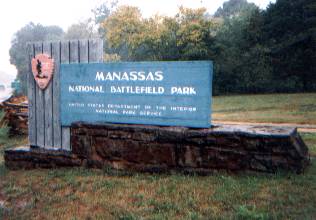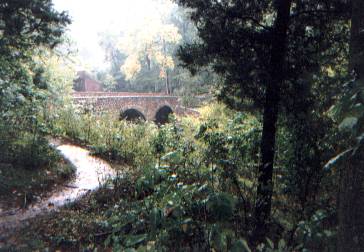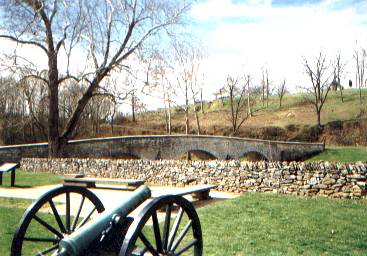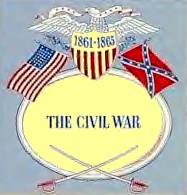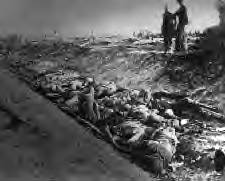|
Antietam 1st Battle of Manassas 2nd Battle of Manassas Fredericksburg |
The first major battle of the Civil War was fought in Virginia, near the Manassas, Virginia railway junction, after which the battle is called (or First Bull Run, named after the flowing stream on the battlefield, if of the Union persuasion).It was fought on July 21 1861. The armies in this first battle were not very large by later Civil War standards. The Federal forces under Brigadier General Irvin McDowell were organized into four divisions (five, if one includes Runyan's division), of about 30,000 men. These divisions were commanded by Tyler, Hunter, Heintzelman, (Runyan), and Miles. The Confederate command structure was somewhat more unwieldy, including two "armies", with no division structure and thirteen independent brigades under Bonham, Ewell, Jones, Longstreet, Cocke, Early, Holmes, Kershaw, Evans, Jackson, Bartow, Bee, Smith, and a cavalry brigade under Stuart. The Confederate Army of the Potomac was under the command of Brigadier General Pierre G. T. Beauregard, and the Army of the Shenandoah was commanded by Brigadier General Joseph E. Johnston. These two forces would equal McDowell's strength. 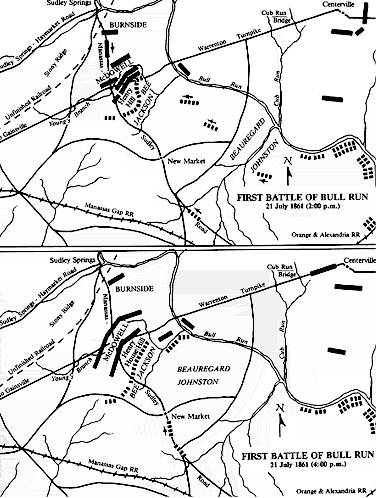 Interestingly enough, each commander had planned to initiate an attack on the other side with a feint attack on the enemy's right flank and a massed attack on the opposite flank. Had this been done simultaneously, and both been successful in their purpose, the two armies would have simply pivoted around each other and ended up in each other's rear, able to march unopposed to Washington or Richmond, as the case may be. As it turned out, the general least successful in initiating this movement was the winner. McDowell had planned to use Tyler's division as the diversionary attack at the Stone Bridge, while Davies' brigade did the same at Blackburn's Ford. At the same time, Hunter's and Heintzelman's divisions would cross Bull Run at Sudley Springs and attack from the north. McDowell's green troops involved in the flanking column, reached their jumping off positions two and a half hours behind schedule. Tyler's and Davies' attacks at the Stone Bridge and Blackburn's Ford were already well under way, and the Confederate high command was beginning to sense a ruse because the Union attacks were not pressed very hard. When Beauregard was notified that Federal troops were massing on his left flank, he realized that this must be the main attack so began to shift his own troop dispositions. The Federals had about 18,000 men in the main attack column and it was only thanks to the quick reactions of Colonel "Shank" Evans and his small brigade that Beauregard did not suffer a major disaster. He quickly moved his small force to Matthew's Hill to block the Federal move. Sounds of the fighting drew other brigade commanders to Evans' aid on their own initiative. Brigadier General Barnard Bee and Colonel Bartow joined Evans' defensive line and deployed their men to his right to extend and strengthen it. The Confederate position was still badly outnumbered however, and eventually the weight of those numbers began to be felt. With Tyler's division threatening the right flank and rear of the Confederate position after having forced a crossing at the Stone Bridge, and their left flank now being overlapped by Federal reinforcements, the three Confederate brigades broke to the rear, heading toward the cleared plateau of the Henry House Hill. Unfortunately for the Federals, they were slow to follow-up their success and allowed the Southern brigade commanders to rally the remnants of their units behind Jackson's brigade which had just arrived and formed a line of battle on the reverse slope of Henry House Hill. In the meantime, McDowell ordered two artillery batteries to advance to silence the defensive fire. Rickett's Battery and Griffin's Battery advanced to well within musket range of the Confederate positions near the crest of the hill. These batteries were counterattacked by Confederate infantry and overrun and although it is still somewhat an open question, most historians give credit to the 33rd Virginia Infantry, although the 6th North Carolina State Troops, and elements of the 2nd Mississippi Infantry also claim credit for silencing Ricketts. This counterattack also routed the infantry supports to the guns -- a battalion of U. S. Marines and the 11th New York Infantry, the famed Fire Zouaves. The loss of the guns became a focal point for see-saw attacks and counterattacks by each side, with the possession of the guns changing hands several times. Finally having accumulated enough units to not only stabilize the Confederate lines, but also overlap the right flank of the Federal lines, the order was given for a general advance by Beauregard. This attack caved-in the Federal right and what began as a fairly orderly retreat turned into a disorganized rout. The equally tired and inexperienced Confederates however, were in no shape to conduct an effective pursuit, so the battle ended. The Federals lost about 3,000 casualties (killed, wounded, and captured or missing), and the Confederates suffered about 2,000.
" Your Website is excellent. I can trust my kids on the internet when i see your site on thier computer favorite foldersquot;Janice Romas--Willings,AL "Frank... I have visited this site every night since i found it!quot;Jerry Creggar--Newark,Dl. "I love your site as it contains SO much information. It is like a book online.."Molly--Civil War Web
Copyright © 2001-2005,Gettysburg Battlefield Online
|
